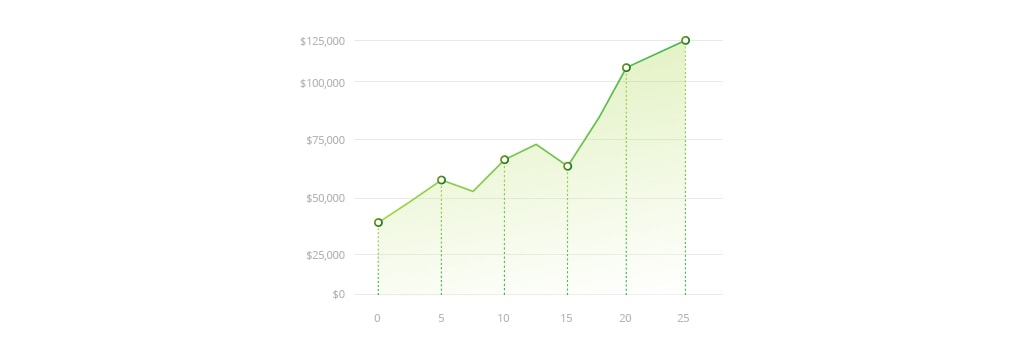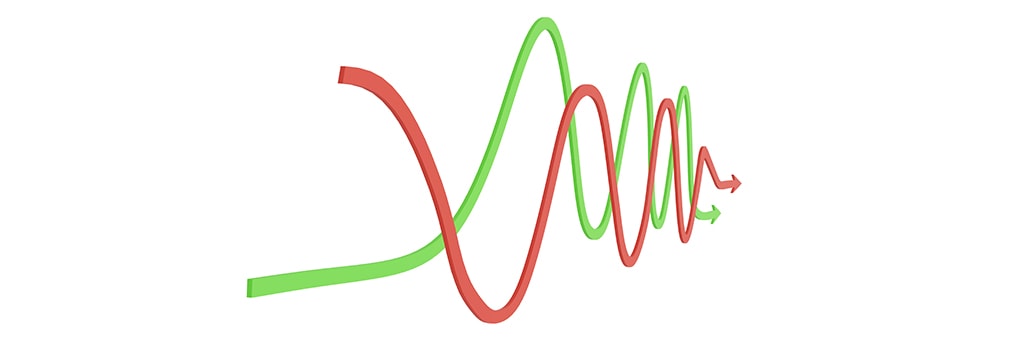The terms investing and trading are often used interchangeably. However, there are key differences between the two financial strategies. The goal of investing is generally to build wealth over the medium to long term. By contrast, the goal of trading is to generate profits in the short-term. In this guide, we take a look at the basics of investing and trading and explain how the two financial strategies differ.
Table of Contents
Investing vs trading: key differences
Investing vs trading: which is better?
What is investing?
Investing is a longer-term buy-and-hold strategy. Investors will often hold assets for years, or even decades, with the aim of generating substantial profits from rising asset prices and any income generated from the assets over time.
An investors exact time horizon (the length of time that the investor expects to invest for) will depend on their financial objectives. For example, someone who is investing for retirement may have a time horizon of 20 years or longer. Someone who is investing to build up a house deposit, on the other hand, may have a time horizon of five years.
A fundamental principle of investing is that the higher the potential return of an investment, the higher the risk of that investment. This is known as the risk-return tradeoff. Risk refers to the chance that an investments actual returns will differ from its expected returns.
The longer an investors time horizon, the more they can focus on higher-growth, higher risk investments. This is because they have more time to ride out market volatility. An investor with a shorter time horizon will need to be more conservative with their investment choices otherwise they run the risk of not achieving their financial goals.
Most investors are comfortable with the fact that financial markets tend to rise and fall in the short term. As a result, they will often ride out periods of underperformance with the expectation that asset prices will eventually rebound and any short-term losses will be recovered.
Investing styles
There are two main styles of investing. These are:
- Active investing: in this approach, investors actively buy and sell securities for their portfolio with the aim of outperforming an investment benchmark index over time. An active stock market investor, for example, might buy 30 individual stocks with the aim of outperforming the S&P 500 index (a stock market index that is composed of 500 large US companies).
- Passive investing: the goal of passive investing is simply to match the performance of a market or benchmark index over time. In this approach, investors do not pick individual securities for their portfolio. Instead, they invest in benchmark-based funds, such as exchange-traded funds (ETFs) and index funds, that aim to track the performance of a market.
What is trading?
Compared to investing, trading is a more active, short-term-focused strategy.
Traders tend to hold assets for a much shorter period of time than investors, often buying and selling securities within weeks, days, or even hours, with the aim of profiting from short-term price movements.
Whereas investors mainly seek to profit from rising asset prices, traders look to profit from both rising and falling asset prices. Instead of focusing on an assets long-term growth prospects like investors do, traders focus on which direction the assets price is likely to head in next and try to profit from that price movement.
While investors often ride out periods of underperformance, traders are more likely to use stop-loss orders to automatically close out losing trades at a predetermined price level. This helps to protect trading capital.
Compared to investing, trading generally requires more time commitment. Whereas an investor can buy a stock or fund and forget about it, a trader needs to be constantly monitoring market developments.

Trading styles
There are a number of different trading styles that traders pursue. These include:
- Scalping: this is a trading strategy that aims to capture small profits, repeatedly. It involves holding a position for a very short amount of time perhaps just a few minutes or even less. Please note that this type of trading is not allowed on TBanque.
- Day trading: this approach to trading involves opening and closing positions within a single day. Closing a trade before the market closes reduces the risks of receiving unfavorable news overnight.
- Position trading: the goal of position trading is to profit from dominant price trends. A trend occurs when an assets price moves in one direction for an extended period of time.
- Swing trading: the aim of swing trading is to focus on larger price movements, rather than identifying the start and finish of a price trend. In this strategy, positions may be held for days to weeks.
What is social trading?
Social trading is an innovative form of trading unique to TBanque that enables individuals to observe the trading strategies of their peers or more experienced traders, and potentially replicate these strategies.
One of the most prominent developments in the financial industry in recent years, it brings traders from different backgrounds together, and allows them to collaborate and copy each others trades.
Social trading offers a number of benefits:
- It allows those with limited financial knowledge to leverage the expertise of more experienced traders. Beginners can interact with talented or experienced traders and learn how to analyse the markets and create profitable strategies.
- It enables traders to potentially improve their performance by working together and sharing ideas.
- It can save traders an enormous amount of research time because everyone shares information.
- It can be used across a wide range of different asset classes including stocks, ETFs, currencies, commodities, and cryptocurrencies.

TBanques CopyTrader feature: a powerful form of social trading
TBanques award-winning CopyTrader technology takes the social trading concept one step further by enabling individuals to automatically replicate the strategies of top-performing traders in real time.
With CopyTrader, anyone can trade like a top trader. Whether youre a beginner learning the basics of trading, an expert that is impressed with another traders track record, or someone who simply lacks the time to research and monitor the financial markets, CopyTrader can help you trade more effectively.
CopyTrader is easy to use: simply choose the traders you wish to copy, decide on the amount of money you want to trade, and copy everything they do automatically, and in real-time, with one click of a button. Whats more, there is no cost to access this service.
Investing vs trading: key differences

Aside from the fact that investing is more long-term focused while trading is more short-term focused, there are plenty of other differences between the two strategies.
Heres a look at three key differences between investing and trading.
Financial markets
The main asset class that investors focus on is stocks.
Stocks, or shares as they are often called, are investments that represent ownership in a company.
Investing in stocks can be a great way to grow your wealth over time. Historically, stocks have delivered excellent returns to investors over the long term.
For example, since the inception of the S&P 500 index in 1926, it has risen by around 10% per year on average.
This is a much higher return than the returns generated by other assets such as bonds and cash savings.

Some investors like to pick individual stocks (such as Apple, Amazon, and Microsoft) themselves. Others prefer to invest in stocks through funds and ETFs that provide broad exposure to the stock market.
Investors also often add other assets to their portfolios in an effort to enhance their returns and lower their portfolio risk. For example, an investor might own a selection of stocks and ETFs, as well as some commodities such as gold and silver, and some cryptoassets such as Bitcoin and Ethereum.
Compared to investors, traders focus on a wider range of asset classes. For example, there are traders that focus on stocks, indices, currencies, commodities, and cryptoassets.
Generally speaking, traders tend to prefer more volatile asset classes as its volatility that creates trading opportunities.
At TBanque, you can trade a wide range of asset classes, including:
Whereas investors usually buy assets outright, traders often use financial instruments such as Contracts For Difference (CFDs) to gain exposure to a certain asset class or security.
CFDs are financial instruments that enable traders to profit from an assets price movements without actually owning the asset.
Most notably they enable traders to trade in both directions (i.e. profit from both upward and downward price movements). They also enable traders to use leverage to control a larger amount of money than they have deposited on the trade.
For example, with X2 leverage, a trader can control $5,000 worth of an asset with a deposit of just $2,500. With X10 leverage, they can control $5,000 with a deposit of just $500. The advantage of using leverage is that it can increase your profits. However, leverage can also magnify your losses so its important to understand the risks.
Research and analysis
Another difference between investors and traders is the way they research their markets and look for opportunities. Typically, investors focus on fundamental analysis.
This type of analysis involves looking at all available information in relation to an asset in order to decide whether to buy or sell that asset.
For example, in the case of a stock, an investor might look at the companys recent revenue and profit growth, its balance sheet, the threat of competitors, and the economic backdrop in order to determine whether the stock is worth buying.
Traders, on the other hand, tend to focus more on technical analysis.
In this type of analysis, traders examine price charts and analyse trends, patterns, and indicators in an effort to predict an assets future price movements. The idea behind technical analysis is that historical price movements can be used to predict future price movements.
Three popular technical analysis strategies include:
- Trend trading: this strategy aims to generate profits by analysing an assets price trend. Once a trader has identified the trend, it may be possible to profit from it by trading in the same direction as the trend.
- Support and resistance trading: this strategy aims to generate profits by identifying an assets support and resistance levels. Support is the level on the chart where the assets price finds it difficult to fall below. Resistance is the level where the assets price finds it difficult to go above. Once these areas have been identified, it may be possible to profit by placing trades at the area where the assets price is likely to reverse.
- Breakout trading: this strategy aims to generate profits by identifying assets that have broken through established support or resistance levels. Breakouts can be strong signals, especially when confirmed by other technical analysis indicators.
Risks and risk management
Investing and trading also have their own unique risks. This means that investors and traders need to manage risk in different ways.
The main risks that investors face are:
- Market risk: this is the risk that a whole market declines in value.
- Specific risk: this is the risk that a specific asset such as a stock or cryptoasset declines in value.
Investors can reduce these risks by diversifying their portfolios. This is the process of spreading money out over many different investments so that youre not overexposed to one asset or security.
A portfolio that has exposure to a wide range of investments, such as many different stocks, a handful of ETFs, some bonds, commodities such as gold and silver, and some cryptoassets will have a much lower overall risk than a portfolio that simply contains one stock or cryptoasset.
The main risks that traders face are:
- Volatility risk: this is the risk associated with short-term price fluctuations.
- Leverage risk: this is the risk associated with using leverage. While leverage can increase your profits, it can also magnify losses.
Risk management strategies for traders include:
- Determining the optimal position size
- Setting stop losses to minimise losses
- Avoiding excessive use of leverage
Investing vs Trading: which is better?
Both investing and trading have their advantages and disadvantages.
One strategy is not better than the other. Both have proven to be successful ways of profiting from the worlds financial markets.
Ultimately, which strategy is suited to you will depend on a variety of factors including:
- Your financial objectives
- Your risk tolerance
- Your understanding of a particular market or asset class
- The amount of time youre willing to dedicate towards research and monitoring your holdings
- The amount of capital you have to get started
Summary: investing vs trading
The differences between investing and trading are summarised in the table below.
Glossary

- CONTRACT FOR DIFFERENCE (CFD) a financial instrument that enables you to profit from the price movements of a security without actually owning the underlying security
- CRYPTOASSET a cryptographically-secured digital asset that can be transferred, stored, and traded electronically
- DIVERSIFICATION spreading your money out over many different investments to lower portfolio risk
- EXCHANGE-TRADED FUND (ETF) an investment fund that aims to track a particular market or index
- FUNDAMENTAL ANALYSIS a form of analysis that involves looking at all available information in relation to an asset
- GOING LONG buying a security
- GOING SHORT selling a security
- LEVERAGE using capital borrowed from a broker when opening a position to increase the potential return of an investment
- MARKET RISK the risk that the whole stock market falls
- RISK the amount of capital exposed on any single trade
- RISK MANAGEMENT focusing on risk when trading in order to minimise losses
- SPECIFIC RISK the risks associated with a particular asset
- STOCKS investments that represent ownership in a company
- TECHNICAL ANALYSIS a form of analysis that focuses on price chart trends, patterns, and indicators
- TIME HORIZON the length of time that an investor expects to invest for
Sign in to TBanque and practice your Investing and Trading skills.
This information is for educational purposes only and should not be taken as investment advice, personal recommendation, or an offer of, or solicitation to, buy or sell any financial instruments. This material has been prepared without regard to any particular investment objectives or financial situation and has not been prepared in accordance with the legal and regulatory requirements to promote independent research. Any references to past performance of a financial instrument, index or a packaged investment product are not, and should not be taken as a reliable indicator of future results. TBanque makes no representation and assumes no liability as to the accuracy or completeness of the content of this guide. Make sure you understand the risks involved in trading before committing any capital. Never risk more than you are prepared to lose.
